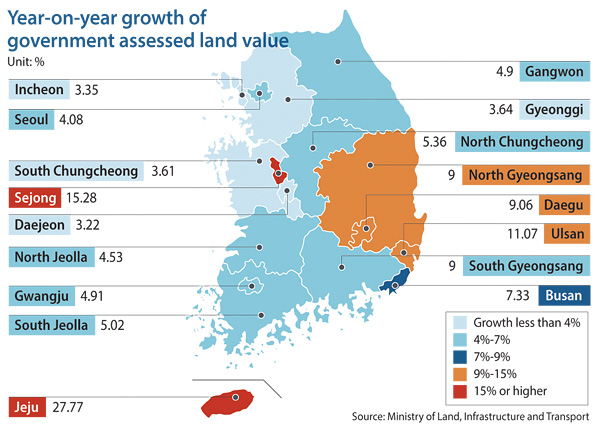Land values rise, particularly outside of Seoul

According to the Ministry of Land, Infrastructure and Transport on Monday, the average assessed value of 32.3 million plots of land throughout the country reported the sharpest growth since 2008, when it surged 10.5 percent. The growth was even higher than last year’s 4.63 percent.
Land outside of the greater Seoul area saw the sharpest growth. Land values in major cities other than Seoul, Gyeonggi and Incheon rose 7.46 percent. Other smaller cities and counties saw their land values rise 7.23 percent. The greater Seoul area saw its land prices increase 3.82 percent.
The government said Seoul saw slower growth because of lack of development or postponed development, including projects in the western area of Gyeonggi such as Ilsan and Deokyang District, Goyang.
Jeju saw the sharpest increase nationally, as its land value surged 27.77 percent compared to a year ago. In Sejong, the rise was 15.28 percent. Ulsan prices went up 11.07 percent, while Daegu prices rose 9 percent.
Jeju land prices surged due to ongoing urban development projects as well as inflows of foreign investment. Sejong land prices went up because of its continued construction as the country’s administrative capital.
Daejeon showed the slowest growth among major cities at 3.22 percent.
Narrowing in on smaller cities and districts, Jeju City and Seogwipo - both on Jeju Island - reported the sharpest increases of 28.79 percent and 26.19 percent, respectively. Haeundae in Busan followed in third with a 17.75 percent increase, while Dong District, Ulsan, came in fourth with 17.04 percent and Yecheon County, North Gyeongsang, was fifth at 16.38 percent.
On average, 11.5 million lots, or 35.6 percent of the total 32.3 million lots, were valued at less than 10,000 won ($8.40) per square meter, while 64.3 percent, or 20.8 million lots, were worth more than 10,000 won and less than 10 million won per square meter. Lots with value exceeding 10 million won per square meter accounted for 0.1 percent, or 30,000 lots.
The most expensive lot in the country was Nature Republic’s 169.3 square meters in Myeong-dong. Each square meter was worth 83.1 million won, nearly 3 percent higher than last year. The lot’s total worth is 14 billion won.
BY LEE HO-JEONG [lee.hojeong@joongang.co.kr]










with the Korea JoongAng Daily
To write comments, please log in to one of the accounts.
Standards Board Policy (0/250자)